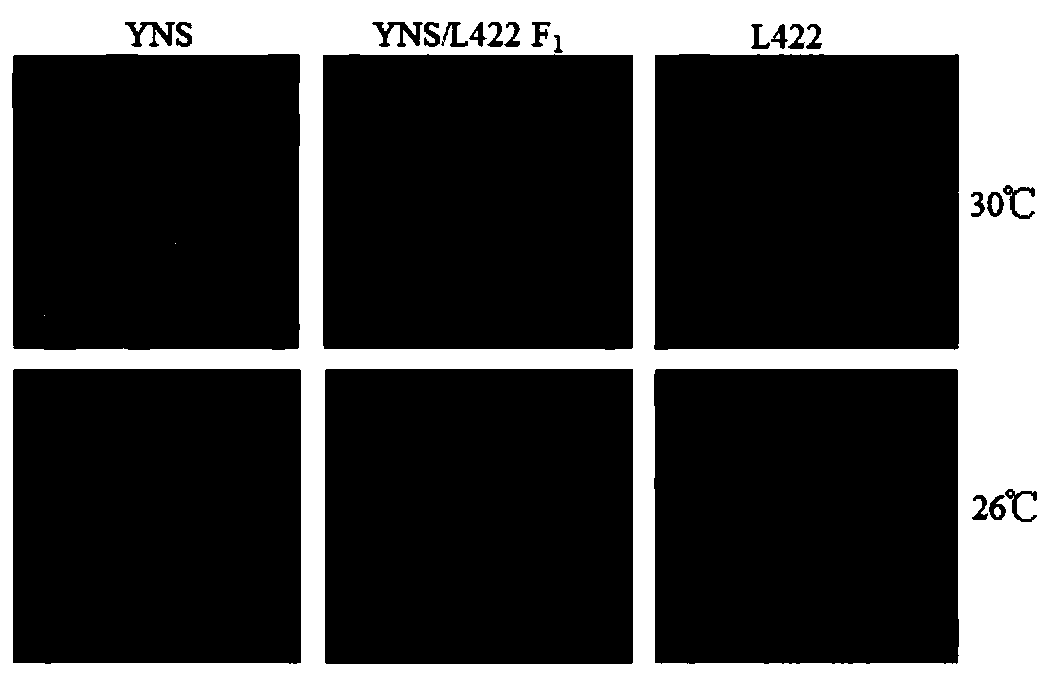Molecular marker of low-temperature-sensitive genic male sterile gene and application thereof
A molecular marker, nuclear sterility technology, applied in the field of crop genetics and breeding, can solve the problems of high risk of seed production, impracticality, and difficulty in guaranteeing, to broaden the geographical scope, enrich the types of practical sterile resources, reduce The effect of seed production risk
- Summary
- Abstract
- Description
- Claims
- Application Information
AI Technical Summary
Problems solved by technology
Method used
Image
Examples
Embodiment 1
[0021] Example 1 Genetic Analysis of Yannong S Low Temperature Sensitive Genic Sterile Traits
[0022] Taking Yannong S (YNS) as the female parent and crossing with the fertile parent Samsara 422 (L422), F 1 and their parents were planted in artificial climate chambers at 26°C and 30°C. Under the condition of 26℃, both F1 and L422 were male fertile, but YNS was male sterile, which indicated that the low temperature sensitive sterility trait was recessive.
[0023] YNS / L422F 2 Groups were planted in Lingshui, Hainan (short-day low temperature conditions). Observation and statistics of fertility segregation at heading stage. In a total of 963 F2 populations, there were 715 fertile individuals and 248 sterile individuals, meeting the genetic segregation ratio of 3 (fertile): 1 (sterile) (χ 2 =0.29<3.84), indicating that low-temperature-sensitive genic sterility traits are controlled by a single recessive gene.
Embodiment 2
[0024] Example 2 Genetic Mapping and Marker Development of Gene rtms10
[0025] DNA pools of fertile individual plants and sterile individual plants were respectively constructed, and a low-temperature-sensitive genic male sterile gene was located on chromosome 10 by Bulked Segregant Analysis, named rtms10, and the expression of the gene was developed. The associated molecular marker ID1305, and the primer sequences are shown in the table below.
[0026]
Embodiment 3
[0027] Molecular cultivation of embodiment 3 inverse thermosensitive genic male sterile line
[0028] Fertile parents Samsara 422, LR009 and Peiai 64 with excellent comprehensive agronomic traits were selected as recurrent parents, crossed with Yannong S, backcrossed for 3 to 4 generations and selfed. Marker ID1305 was used in each segregation generation (PCR reaction system: 50ng DNA; 5ul TAKARA rTaq buffer; 2ul each of upstream and downstream primers at a concentration of 10mM; 5ul of dNTPs at a concentration of 2.5mM; 30sec, 32 cycles; 72°C for 5min) Individual plants and lines carrying the rtms10 gene and excellent agronomic traits were selected and bred, and a practical reverse temperature-sensitive genic male sterile line with excellent agronomic traits was obtained. Among them, the molecular marker ID1305 on YNS and L422 F 2 See the expansion results of low-temperature sterile plants in the isolated population figure 2 , M: DNA marker; L: Samsara 422; Y: YNS; 1-38: F...
PUM
 Login to View More
Login to View More Abstract
Description
Claims
Application Information
 Login to View More
Login to View More - Generate Ideas
- Intellectual Property
- Life Sciences
- Materials
- Tech Scout
- Unparalleled Data Quality
- Higher Quality Content
- 60% Fewer Hallucinations
Browse by: Latest US Patents, China's latest patents, Technical Efficacy Thesaurus, Application Domain, Technology Topic, Popular Technical Reports.
© 2025 PatSnap. All rights reserved.Legal|Privacy policy|Modern Slavery Act Transparency Statement|Sitemap|About US| Contact US: help@patsnap.com



